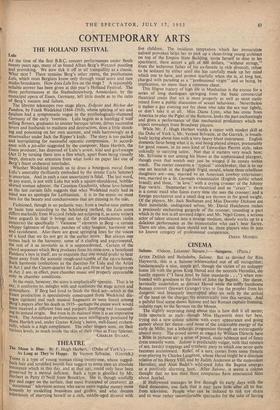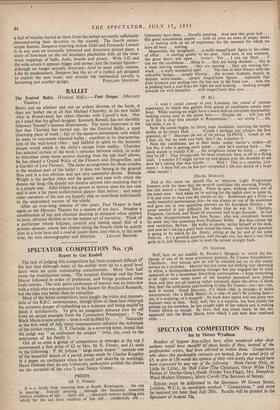CINEMA
Salome. (Odeon, Leicester Square.)--Sangaree. (Plaza.) AFTER Delilah and Bathsheba, Salome. But as devised for Rita Hayworth, this is a Salome whitewashed out of all recognition; fundamentally a nice, simple girl, though the victim of an unhappy home life with the gross King Herod and the neurotic Herodias, she hastily repents ("I have lived by false standards . . .") when con- fronted with goodness in the form of John the Baptist. Her dance, heroically undertaken to distract Herod while the stiffly handsome Roman convert (Stewart Granger) tries to free the prophet from his dungeon, and brusquely interrupted after six veils by the arrival of the head on the charger, fits eccentrically into this version. And a painful final scene shows Salome and her Roman captain listening, suitably rapt, to the Sermon on the Mount. The slightly surprising thing about this is how dull it all seems; little spectacle as such—though Miss Hayworth does her best, trying out a new colour scheme with every appearance and going gamely about her dance—and none of, the undeniable energy of the early de Mille; just a lethargic progression through an extravagantly absurd story. The crowd scenes as staged by William Dieterle have a Bible in pictures air: a sense of posed, static tableaux and of fancy dress uneasily worn. Salome is predictably vulgar, with that mixture of sex, tawdry trappings and synthetic piety to which one never quite becomes accustomed. Relief, of a sort, comes from some frenetic over-playing by Charles Laughton, whose Herod 'might be a dissolute relative of his Henry VIII, and by Judith Anderson as the malevolent Herodias; and Alan Badel's wild-eyed John the Baptist emerges as a positively alarming bore. After Salome, it seems a solemn thought that no less than three companies have announced films about Jezebel.
If Hollywood manages to live through its early days with the third dimension, one feels that it may have little after all to fear from television. People who can be induced to risk eye strain and to wear rather uncomfortable spectacles for the sake of having a hail of missiles hurled at them from the screen are surely sufficiently demonstrating their devotion to the cinemd. The fourth stereo- scopic feature, Sangaree (starring Arlene Dahl and Fernando Lamas) is in any case an unusually laboured and discursive period piece, a story of love-hate on the old Southern plantation with all the time- worn trappings of balls, duels, brawls and piracy. With 3-D and the wide screen it appears bigger and slower; and the human figures— although no longer actually distorted—tend to seem oddly remote. Like its predecessors, Sangaree has the air of a rushed job designed to exploit the new craze; and already the mechanical novelty is



























 Previous page
Previous page